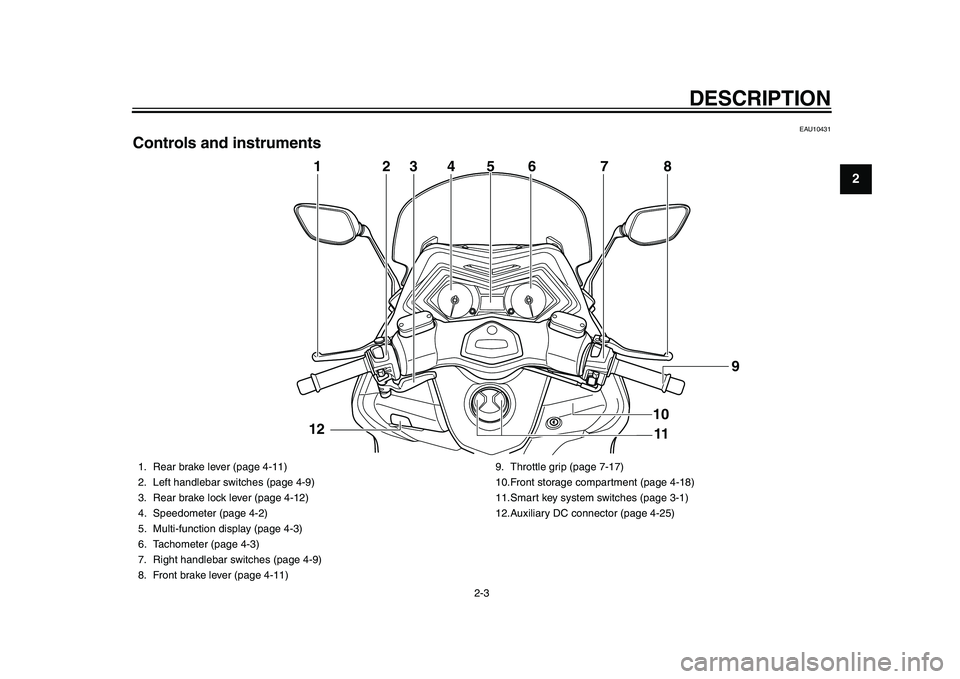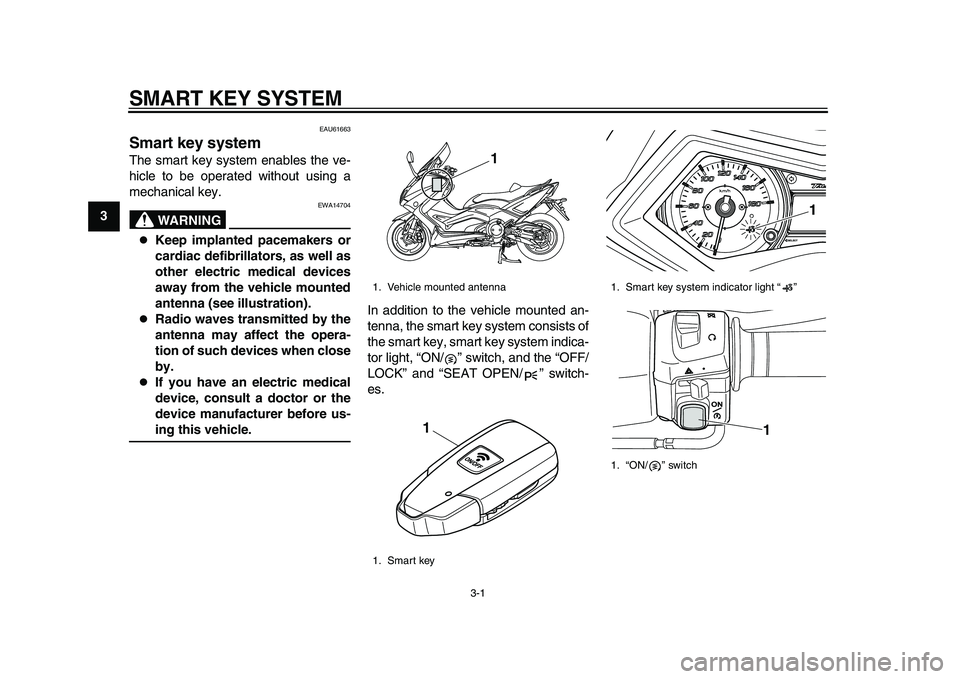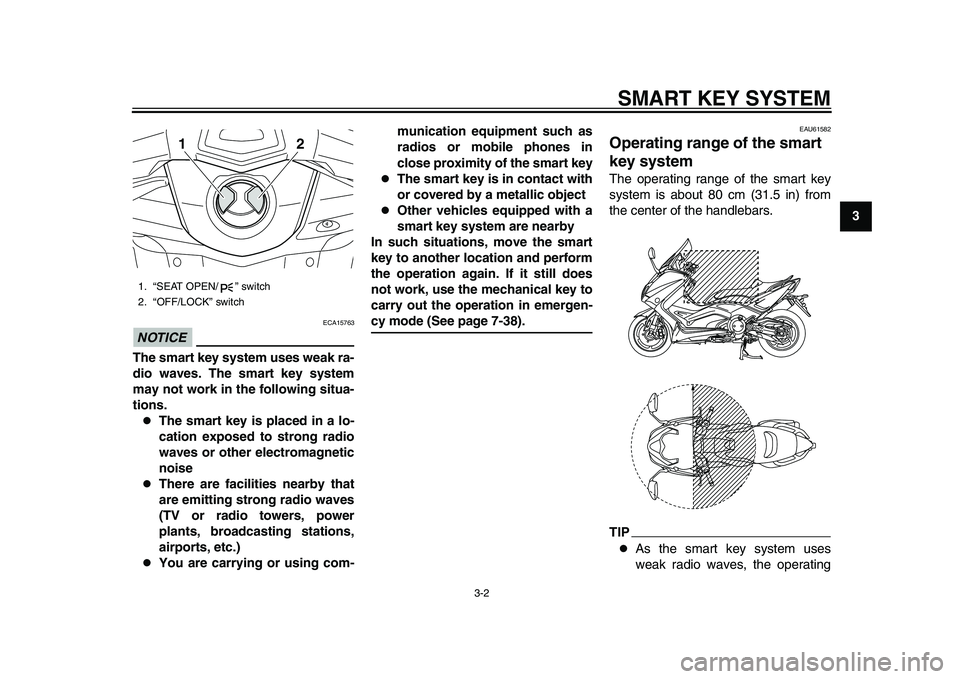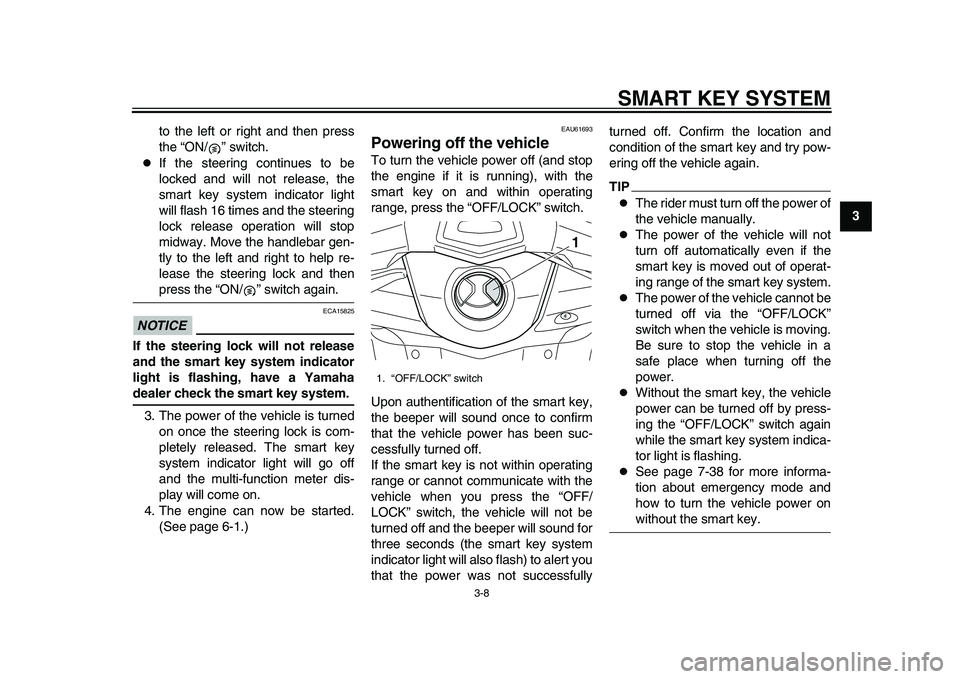lock YAMAHA TMAX 2015 Owners Manual
[x] Cancel search | Manufacturer: YAMAHA, Model Year: 2015, Model line: TMAX, Model: YAMAHA TMAX 2015Pages: 112, PDF Size: 6.38 MB
Page 8 of 112

TABLE OF CONTENTSSAFETY INFORMATION................... 1-1
Further safe-riding points................. 1-5
DESCRIPTION ................................... 2-1
Left view .......................................... 2-1
Right view ........................................ 2-2
Controls and instrument s................. 2-3
SMART KEY SYSTEM ....................... 3-1
Smart key system ......... ................... 3-1
Operating range of the smart key
system ....................... ................... 3-2
Handling of the smart key and mechanical key ............................ 3-3
Smart key ........................................ 3-5
Replacing the smart key battery ...... 3-6
Vehicle power on and steering lock release .................................. 3-7
Powering off th e vehicle .................. 3-8
How to lock the steering .................. 3-9
Seat opening and closin g ................ 3-9
Parking mode ................................ 3-10
INSTRUMENT AND CONTROL
FUNCTIONS ....................................... 4-1
Indicator lights and warning lights ... 4-1
Speedometer ................................... 4-2
Tachometer ..................................... 4-3
Multi-function display ....................... 4-3
Handlebar switches ......................... 4-9
Front brake lever ........................... 4-11 Rear brake lever............................ 4-11
Rear brake lock lever .................... 4-12
ABS (for ABS models)...
................ 4-13
Fuel tank cap................................. 4-14
Fuel ............................................... 4-15
Catalytic converter ........................ 4-16
Adjusting the rider backrest........... 4-17
Helmet holder ................................ 4-17
Storage compartments .................. 4-18
Windshield..................................... 4-20
Rear view mirrors .......................... 4-21
Shock absorber assembly ............. 4-22
Sidestand ...................................... 4-22
Ignition circuit cut- off system ......... 4-23
Auxiliary DC connector.................. 4-25
FOR YOUR SAFETY –
PRE-OPERATION CHECKS ............. 5-1
OPERATION AND IMPORTANT
RIDING POINTS ................................. 6-1
Starting the engine .......................... 6-1
Starting off ....................................... 6-2
Acceleration and deceleration ......... 6-3
Braking ............................................ 6-3
Tips for reducing fuel consumption ................................ 6-4
Engine break-in ............................... 6-4
Parking ............................................ 6-5 PERIODIC MAINTENANCE AND
ADJUSTMENT
.................................... 7-1
Owner’s tool kit ................................ 7-2
Periodic maintenance chart for the emission control syst em ............... 7-3
General maintenance and lubrication chart ............................ 7-4
Removing and installing panels ....... 7-8
Checking the spark plugs .............. 7-10
Engine oil and oil filt er cartridge..... 7-11
Coolant .......................................... 7-14
Replacing the air filter element ...... 7-16
Adjusting the engine idling speed............ ............................ .. 7-16
Checking the throttle grip free play ............................................. 7-17
Valve clearance ............................. 7-17
Tires ............................................... 7-18
Cast wheels ................................... 7-20
Checking the front and rear brake
lever free play ............................. 7-20
Adjusting the rear brake lock cable ........................................... 7-21
Checking the rear brake lock ......... 7-22
Checking the front and rear brake pads............................................ 7-22
Checking the brake fluid level ........ 7-23
Changing the brake fluid ................ 7-24
Drive belt slack .............................. 7-24
Checking and lubricating the
cables
......................................... 7-25
2PW-9-E0_1.book 1 ページ 2015年2月19日 木曜日 午後3時30分
Page 17 of 112

DESCRIPTION
2-3
123
4
5
6
7
8
9
10
11
12
EAU10431
Controls and instruments
4
2
3
6
7
8
1
11 9
5
10
12
1. Rear brake lever (page 4-11)
2. Left handlebar switches (page 4-9)
3. Rear brake lock lever (page 4-12)
4. Speedometer (page 4-2)
5. Multi-function display (page 4-3)
6. Tachometer (page 4-3)
7. Right handlebar switches (page 4-9)
8. Front brake lever (page 4-11) 9. Throttle grip (page 7-17)
10.Front storage compartment (page 4-18)
11.Smart key system switches (page 3-1)
12.Auxiliary DC connector (page 4-25)
2PW-9-E0_1.book 3 ページ 2015年2月19日 木曜日 午後3時30分
Page 18 of 112

3-1
1
23
4
5
6
7
8
9
10
11
12
SMART KEY SYSTEM
EAU61663
Smart key systemThe smart key system enables the ve-
hicle to be operated without using a
mechanical key.
WARNING
EWA14704
Keep implanted pacemakers or
cardiac defibrillators, as well as
other electric medical devices
away from the vehicle mounted
antenna (see illustration).
Radio waves transmitted by the
antenna may affect the opera-
tion of such devices when close
by.
If you have an electric medical
device, consult a doctor or the
device manufacturer before us-ing this vehicle. In addition to the vehicle mounted an-
tenna, the smart key system consists of
the smart key, smart key system indica-
tor light, “ON/ ” switch, and the “OFF/
LOCK” and “SEAT OPEN/ ” switch-
es.
1. Vehicle mounted antenna
1. Smart key
1
1
1. Smart key system indicator light “ ”
1. “ON/ ” switch
1
1
2PW-9-E0_1.book 1 ページ 2015年2月19日 木曜日 午後3時30分
Page 19 of 112

SMART KEY SYSTEM
3-2
1
234
5
6
7
8
9
10
11
12
NOTICE
ECA15763
The smart key system uses weak ra-
dio waves. The smart key system
may not work in the following situa-
tions.
The smart key is placed in a lo-
cation exposed to strong radio
waves or other electromagnetic
noise
There are facilities nearby that
are emitting strong radio waves
(TV or radio towers, power
plants, broadcasting stations,
airports, etc.)
You are carrying or using com- munication equipment such as
radios or mobile phones in
close proximity of the smart key
The smart key is in contact with
or covered by a metallic object
Other vehicles equipped with a
smart key system are nearby
In such situations, move the smart
key to another location and perform
the operation again. If it still does
not work, use the mechanical key to
carry out the operation in emergen-
cy mode (See page 7-38).
EAU61582
Operating range of the smart
key systemThe operating range of the smart key
system is about 80 cm (31.5 in) from
the center of the handlebars.TIP
As the smart key system uses
weak radio waves, the operating
1. “SEAT OPEN/ ” switch
2. “OFF/LOCK” switch
1
2
2PW-9-E0_1.book 2 ページ 2015年2月19日 木曜日 午後3時30分
Page 20 of 112

SMART KEY SYSTEM
3-3
1
23
4
5
6
7
8
9
10
11
12 range may be affected by the sur-
rounding environment.
When the battery of the smart key
is discharged, the smart key may
not work or its operating range be-
come very small.
If the smart key is turned off, the
vehicle will not recognize the smart
key even if it is within operating
range.
If the “ON/ ” switch, “OFF/LOCK”
switch, or “SEAT OPEN/ ”
switch are repeatedly pressed
when the smart key is out of range
or cannot communicate with the
vehicle, all switches will be tempo-
rarily disabled.
Placing the smart key in the front
or rear storage compartment may
block communication between the
smart key and the vehicle. If the
rear trunk is locked with the smart
key inside, the smart key system
may be disabled. The smart key
should always be carried on your
person.
When leaving the vehicle, make
sure you apply the steering lock
and take the smart key with you. It is recommended that you turn the
smart key off.
EAU61643
Handling of the
smart key and
mechanical key
WARNING
EWA17952
The smart key should be carried
with you. Do not store it on the
vehicle.
When the smart key is within op-
erating range, exercise due care
because other people not carry-
ing the smart key can start theengine and operate the vehicle.
Included with the vehicle is one smart
key (with a built-in mechanical key) and
one spare mechanical key with an iden-
tification tag. Keep the spare mechani-
cal key and tag separate from the smart
key. Should you lose or damage the
smart key, or when its battery is dis-
charged, the mechanical key will serve
as a back up. The seat can be opened,
the smart key system identification
number can be manually input, and
then the vehicle can be operated. (See
page 7-38.) We recommend that you
note down the identification number
in case of emergency.
2PW-9-E0_1.book 3 ページ 2015年2月19日 木曜日 午後3時30分
Page 23 of 112

SMART KEY SYSTEM
3-6
1
234
5
6
7
8
9
10
11
12
ment, and the seat lock. (See page
4-14, 4-18, and 7-38.)
EAU61603
Replacing the smart key
batteryReplace the battery in the following sit-
uations.
The smart key system indicator
light flashes for about 20 seconds
when the power of the vehicle is
turned on.
When the smart key indicator light
does not come on when the “ON/
OFF” switch is pushed.WARNING
EWA14724
The battery and other remov-
able parts may cause injury if
swallowed. Keep the battery and other removable parts away
from children.
Do not expose the battery to di-
rect sunlight or other heatsources.
NOTICE
ECA15784
Use a cloth when opening the
smart key case with a screw-
driver. Direct contact with hard
objects may damage or scratch
the smart key.
Take precautions to prevent the
waterproof seal from being
damaged or contaminated by
dirt.
Do not touch the internal cir-
cuits and terminals. This may
cause malfunctions.
Do not apply excessive force to
the smart key when replacing
the battery.
Make sure the battery is in-
stalled correctly. Confirm the di-
rection of the positive/“+” sideof the battery.
1. Smart key system indicator light “ ”
1
2PW-9-E0_1.book 6 ページ 2015年2月19日 木曜日 午後3時30分
Page 24 of 112

SMART KEY SYSTEM
3-7
1
23
4
5
6
7
8
9
10
11
12 To replace the smart key battery
1. Open the smart key case as shown.
2. Remove the switch plate and con- trol unit from the smart key case.
3. Remove the battery cover. 4. Remove the battery.
TIPDispose of the removed battery in ac-cordance with local regulations.
5. Install a new battery as shown. Note the polarity of the battery.
6. Install the battery cover.
7. Install the switch plate and control unit into the smart key case.
8. Gently snap the smart key case closed.
EAU61633
Vehicle power on and steering
lock release1. With the smart key on and in oper-ating range, press the “ON/ ”
switch for one second.
2. Upon authentication of the smart key, the beeper will sound twice,
the smart key system indicator
light will come on momentarily and
the steering lock (if applied) will re-
lease automatically.TIP
The smart key system indicator
light will flash if the steering lock
cannot automatically release itself.
Try moving the handlebars gently
1. Battery cover
2. Control unit
3. Switch plate
3
1
2
Specified battery:
CR20251. Battery
2. Control unit
2 1
1. “ON/ ” switch
1
2PW-9-E0_1.book 7 ページ 2015年2月19日 木曜日 午後3時30分
Page 25 of 112

SMART KEY SYSTEM
3-8
1
234
5
6
7
8
9
10
11
12
to the left or right and then press
the “ON/ ” switch.
If the steering continues to be
locked and will not release, the
smart key system indicator light
will flash 16 times and the steering
lock release operation will stop
midway. Move the handlebar gen-
tly to the left and right to help re-
lease the steering lock and thenpress the “ON/ ” switch again.
NOTICE
ECA15825
If the steering lock will not release
and the smart key system indicator
light is flashing, have a Yamahadealer check the smart key system.
3. The power of the vehicle is turned on once the steering lock is com-
pletely released. The smart key
system indicator light will go off
and the multi-function meter dis-
play will come on.
4. The engine can now be started. (See page 6-1.)
EAU61693
Powering off the vehicleTo turn the vehicle power off (and stop
the engine if it is running), with the
smart key on and within operating
range, press the “OFF/LOCK” switch.
Upon authentification of the smart key,
the beeper will sound once to confirm
that the vehicle power has been suc-
cessfully turned off.
If the smart key is not within operating
range or cannot communicate with the
vehicle when you press the “OFF/
LOCK” switch, the vehicle will not be
turned off and the beeper will sound for
three seconds (the smart key system
indicator light will also flash) to alert you
that the power was not successfully turned off. Confirm the location and
condition of the smart key and try pow-
ering off the vehicle again.
TIP
The rider must turn off the power of
the vehicle manually.
The power of the vehicle will not
turn off automatically even if the
smart key is moved out of operat-
ing range of the smart key system.
The power of the vehicle cannot be
turned off via the “OFF/LOCK”
switch when the vehicle is moving.
Be sure to stop the vehicle in a
safe place when turning off the
power.
Without the smart key, the vehicle
power can be turned off by press-
ing the “OFF/LOCK” switch again
while the smart key system indica-
tor light is flashing.
See page 7-38 for more informa-
tion about emergency mode and
how to turn the vehicle power onwithout the smart key.
1. “OFF/LOCK” switch
1
2PW-9-E0_1.book 8 ページ 2015年2月19日 木曜日 午後3時30分
Page 26 of 112

SMART KEY SYSTEM
3-9
1
23
4
5
6
7
8
9
10
11
12
EAU61612
How to lock the steeringAfter moving the vehicle to a safe park-
ing place, turn off the power of the vehi-
cle. Turn the handlebars fully to the left
and then press the “OFF/LOCK” switch
for at least one second.TIP
If the steering lock function locks
correctly, the beeper will sound
once.
If the steering lock function does
not lock correctly, the beeper will
sound for three seconds and the
smart key system indicator light
will flash. Turn the handlebar fully
to the left one more time and press
the “OFF/LOCK” switch again for
one second.WARNING
EWA14742
Do not operate the steering lockwhile the vehicle is moving.
EAU61683
Seat opening and closingTo open the seat 1. Place the vehicle on the center- stand.
2. With the smart key on and in oper- ating range, press the “SEAT
OPEN/ ” switch.
3. The seat lock will release upon au- thentication of the smart key.
4. Fold the seat up.1. “SEAT OPEN/ ” switch
1
2PW-9-E0_1.book 9 ページ 2015年2月19日 木曜日 午後3時30分
Page 27 of 112

SMART KEY SYSTEM
3-10
1
234
5
6
7
8
9
10
11
12
WARNING
EWA17941
Do not operate the “SEAT OPEN/ ”switch while the vehicle is moving.
To close the seat
Fold the seat down, and then push it
down to lock it in place.TIP
Make sure the seat is properly
closed before starting off.
In case of an emergency, the seat
can be opened with a mechanicalkey. (See page 7-38.)
EAU61593
Parking modeThe steering is locked, and the hazard
lights and turn signal lights can be
turned on, but all other electrical sys-
tems are off.
To enter parking mode 1. Lock the steering. (See page 3-9. )
2. Press and hold the “SEAT OPEN/ ” switch for at least one second.
3. Upon authentification of the smart key, the beeper will sound twice
and the smart key system will
change to parking mode and the
smart key system indicator light
will come on.TIPThe seat cannot be opened while inparking mode.NOTICE
ECA21990
Do not use the hazard lights for an
extended length of time, otherwisethe battery may discharge. To exit parking mode
Press and hold the “SEAT OPEN/ ”
switch. Upon authentication of the
smart key, the beeper will sound once
and parking mode is cancelled and the
smart key system indicator light will go
off.
2PW-9-E0_1.book 10 ページ 2015年2月19日 木曜日 午後3時30分